Summary
This paper evaluates cryptocurrency investments as an asset class relative to traditional asset classes, including U.S. stocks and bonds. The analysis examines the returns and volatility of bitcoin, the most mature cryptocurrency, both on a standalone basis and in the context of a diversified portfolio. The goal of the analysis is to illuminate the potential benefit cryptocurrencies offer as an investment.
Crypto is a new asset class
Crypto awareness driven by outsized risk and return
Bitcoin, the first massively adopted cryptocurrency was launched ten years ago. Since then cryptocurrencies have grown to become a global economic phenomenon that is attracting talent, attention, and investment.
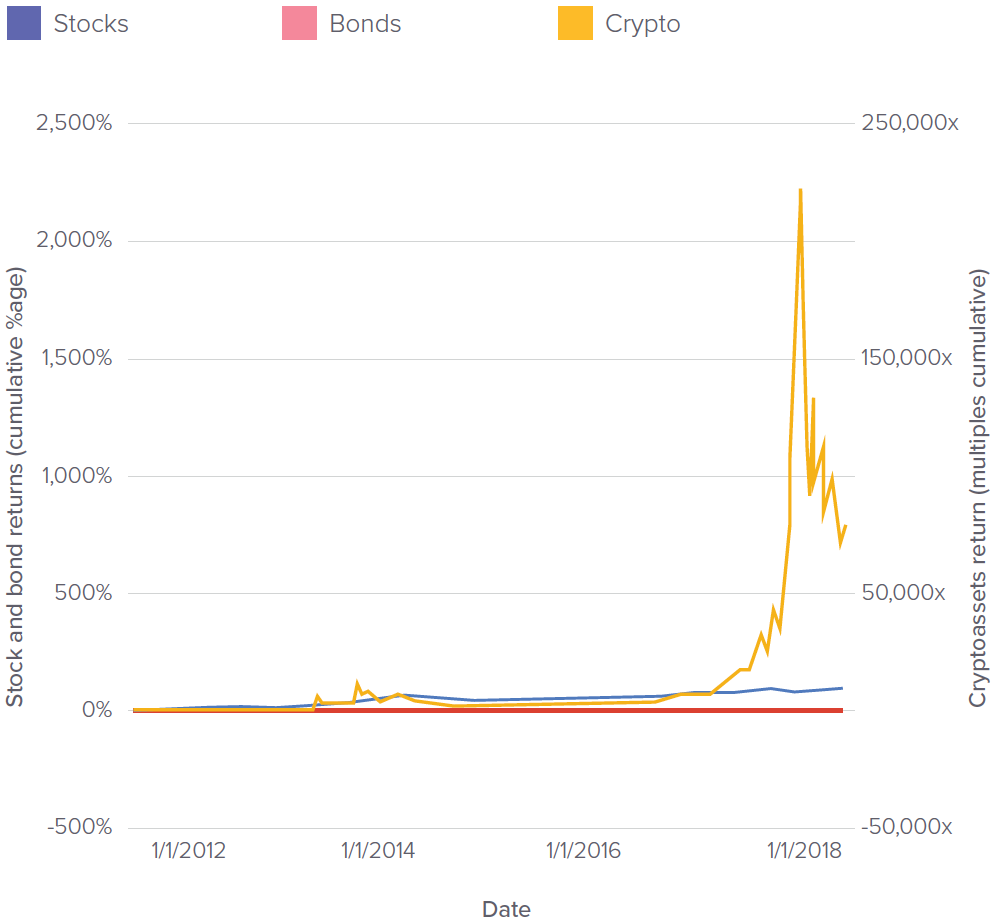
The price of bitcoin has climbed precipitously since 2010. Near the end of 2017, the price of one bitcoin surpassed the $20,000 mark, which stoked further interest in cryptocurrencies from a wide range of investors.
This paper examines the investment potential of cryptocurrencies through a mean-variance framework, and considers their outcomes on a standalone basis and in the context of a traditional, diversified investment portfolio. This paper builds on growing evidence that cryptocurrencies represent their own asset class and observes a substantial diversification benefit when cryptocurrencies are included in stock and bond portfolios. This advantage remained even when portfolio optimization and weighting constraints applied.
Given the various uses of cryptocurrencies, this paper further refers to the class of assets representing bitcoin, ether, litecoin, and others as cryptoassets, a more generalizable and less confusing term popularized by others1. The following analyses of returns and volatility focus on bitcoin, the longest tenured and largest capitalization cryptoasset. Bitcoin market data is used for all cryptoasset charts and figures unless otherwise specified.
Cryptos are uncorrelated with traditional asset classes
Cryptoassets are evaluated as a new asset class, not only because of their distinctive fundamental qualities (such as an algorithmic supply schedule, decentralized governance, multifaceted usage, and different basis of value2), but also based on market data. Specifically, the correlations between cryptoassets and traditional asset classes are low, while the correlations within the cryptoasset class are higher.
The table below compares the correlations of traditional asset classes with each other, versus their correlation with cryptoassets since the 2010 inception of the first bitcoin exchange.3
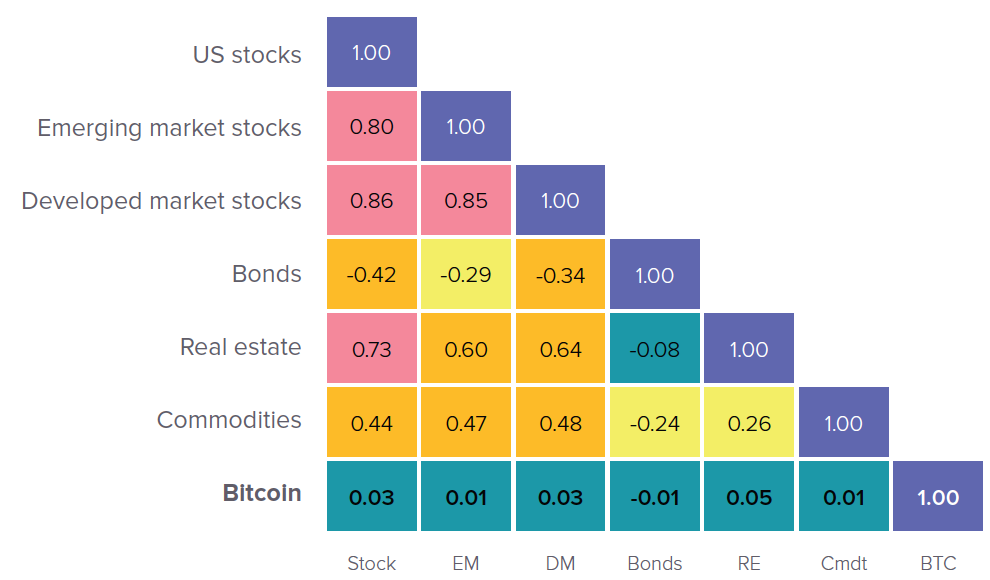
Bitcoin exhibits a markedly lower correlation, observed at or below 0.05, with all other classes. This is a substantially lower figure than nearly any other asset class pair. This low correlation hints at the potential for diversification that cryptoassets may offer to traditional asset portfolios. Especially significant in a portfolio context is understanding if cryptoassets will remain uncorrelated with traditional asset classes during market corrections. If cryptoasset correlations were to increase toward a measurement of 1.00 under such circumstances, the expected protective effect would be limited, regardless of historical correlations near 0.
The chart below, displaying historical 90-day rolling correlations relative to stocks and bonds, reveals the low correlation between cryptoassets and traditional assets over time.
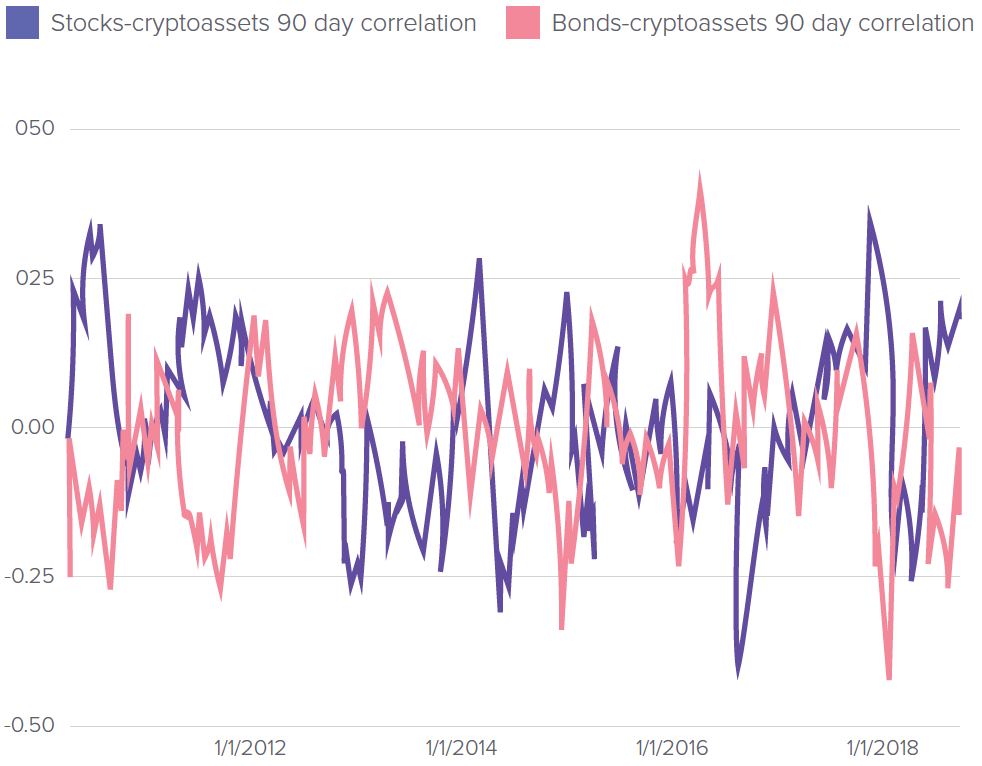
While the rolling correlation is not completely stable, observed values tended to remain within a consistent range of about – 0.25 to 0.25, never having exceeded a wider correlation band than – 0.5 to 0.5. The relative consistency of the range reinforces the concept that cryptoassets are uncorrelated with traditional investments, and could potentially provide a diversification benefit to stock and bond portfolios.
It’s important to note that while the lack of correlation between cryptoasset markets and traditional asset markets is a historical trend, it does not necessarily mean that the trend will continue. In fact, correlations may rise over time as the cryptoasset marketplace matures, cryptoassets’ usage and economic value become clearer, and cryptoassets begin to share more capital pools with traditional assets.4
Individual cryptoasset correlations are higher
Correlation data can also be used to investigate the coherence of cryptoassets as a class. If cryptoassets were entirely uncorrelated with each other, their grouping as an asset class would not make much sense. The correlation table below looks at pairings of individual cryptoassets since their inception to quantify their similarity.
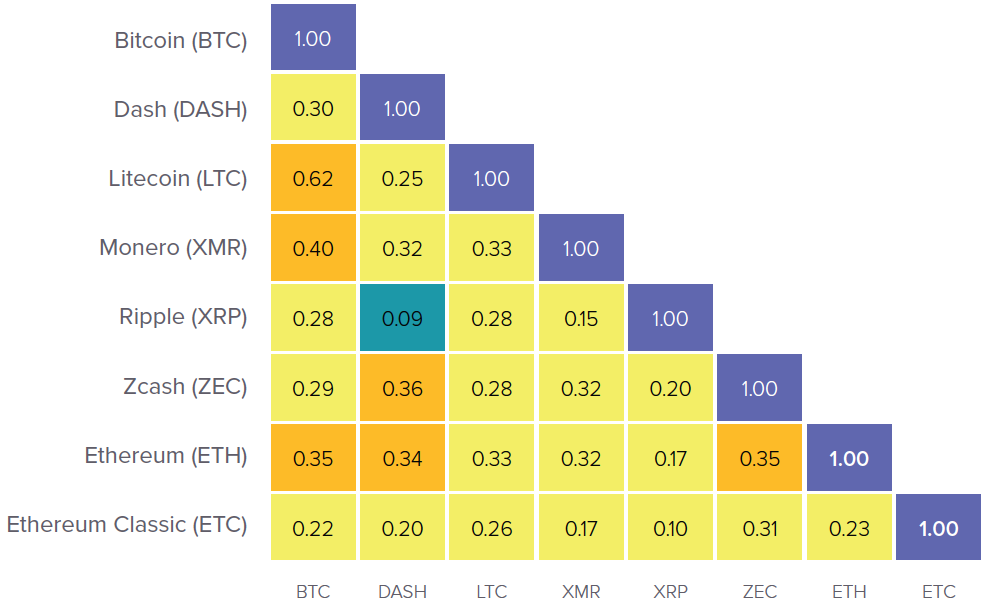
In contrast to the correlation table featuring traditional assets in the previous section, this correlation table indicates that cryptoassets are more alike when compared with other cryptoassets. For example, bitcoin’s correlation with other individual cryptoassets ranges from 0.15 to 0.62. That the correlations are higher than bitcoin’s correlation with traditional asset classes (all of which were less than 0.05) supports the notion that cryptoassets are a distinct asset class.
The right kind of risk creates greater returns
Cryptoasset gains and losses ranged widely throughout time
The relatively extreme returns and volatility observed in cryptoassets generally are consistent with their behavior at more granular intervals. A simple comparison between cryptoassets and traditional assets shows that in many years, cryptoasset gains and losses far exceeded those of traditional asset classes.
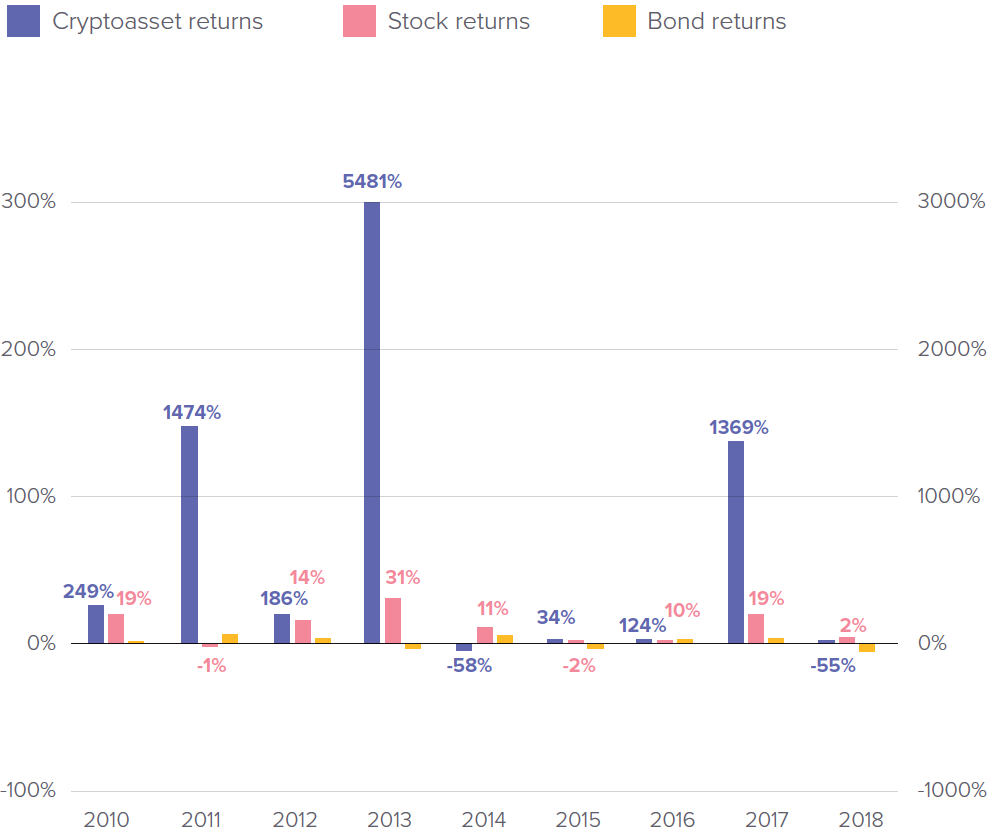
In seven of the nine years observed, cryptoasset returns exceeded traditional asset index returns by at least an order of magnitude. In two of those years, the absolute losses of cryptoassets were larger than stock and bond gains by an order of magnitude.
Commensurate with outsize gains and losses, volatility has been elevated throughout cryptoassets’ lifetime. The chart below shows the volatility (measured as annualized standard deviation) of stocks, bonds, and cryptoassets.
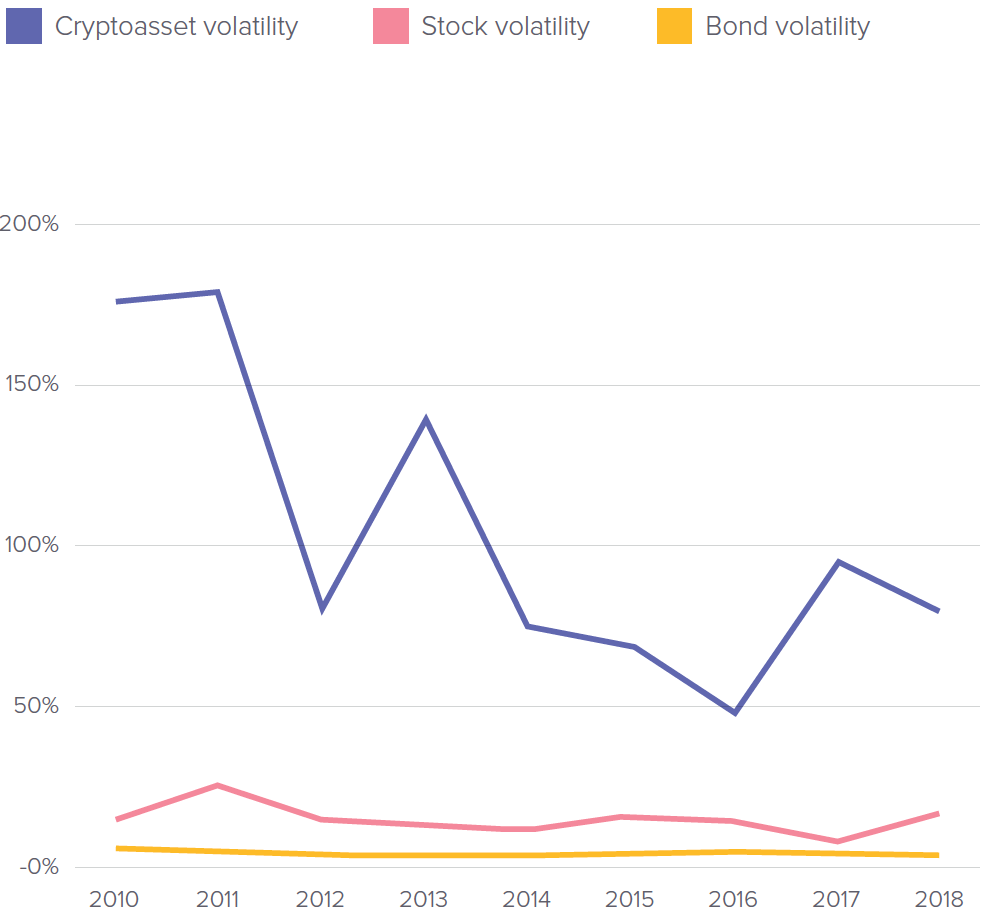
It is unsurprising to see that cryptoasset volatility has far exceeded that of traditional assets in all years. That realized is multiples of those in traditional assets bears further examination of performance on a risk-adjusted basis.
Making comparisons between different asset classes with the Sharpe ratio
To evaluate performance on a risk-adjusted basis, the next chart shows the Sharpe ratio of cryptoassets against those of stocks and bonds.
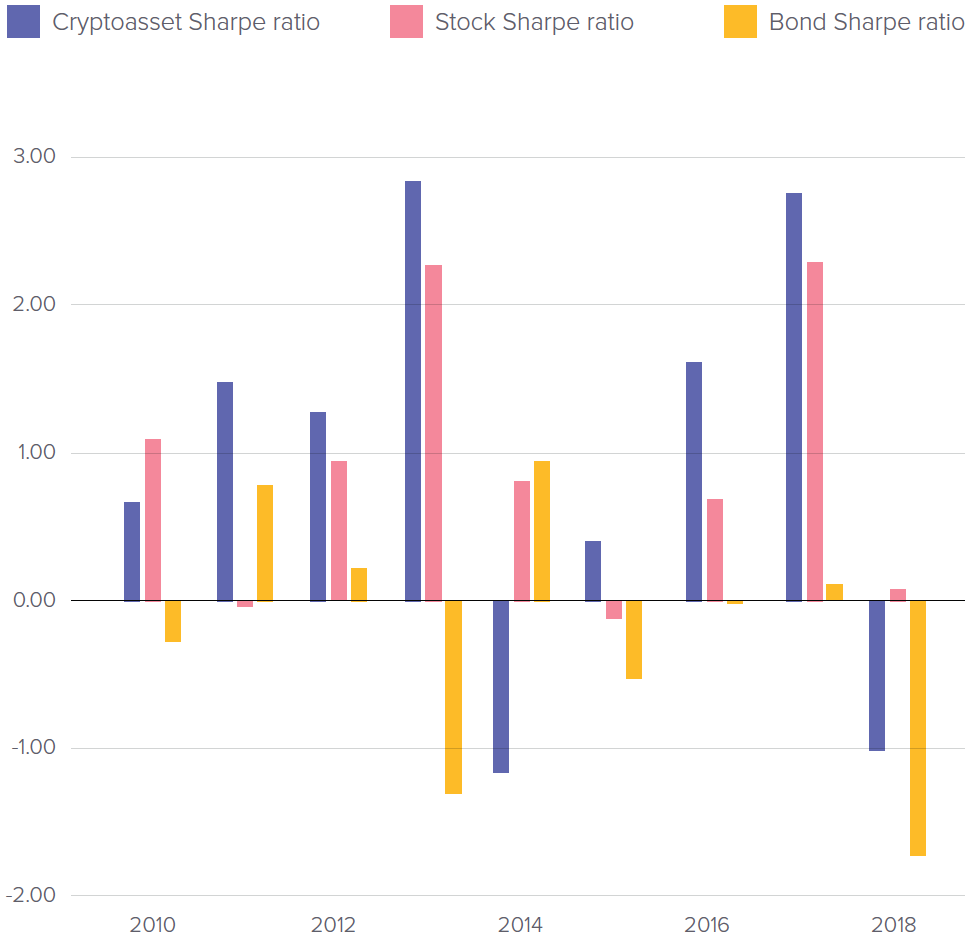
The returns of cryptoassets relative to risk, as measured by their Sharpe ratio, are superior in six of the previous nine years. On balance, it appears that the returns of cryptoassets have been relatively high compared to their volatility, and that there is promising indication they may serve substantial benefit to traditional investment portfolios.
Cryptoassets shift the efficient frontier upward
In order to obtain a more specific view on the impact of a cryptoassets allocation, the chart below compares the efficient frontier between traditional portfolios comprised of stocks and bonds, and portfolios comprised of those same asset classes augmented by cryptoassets. Each line on the chart plots the maximal returns that can be obtained using different asset weightings to target a given level of volatility.
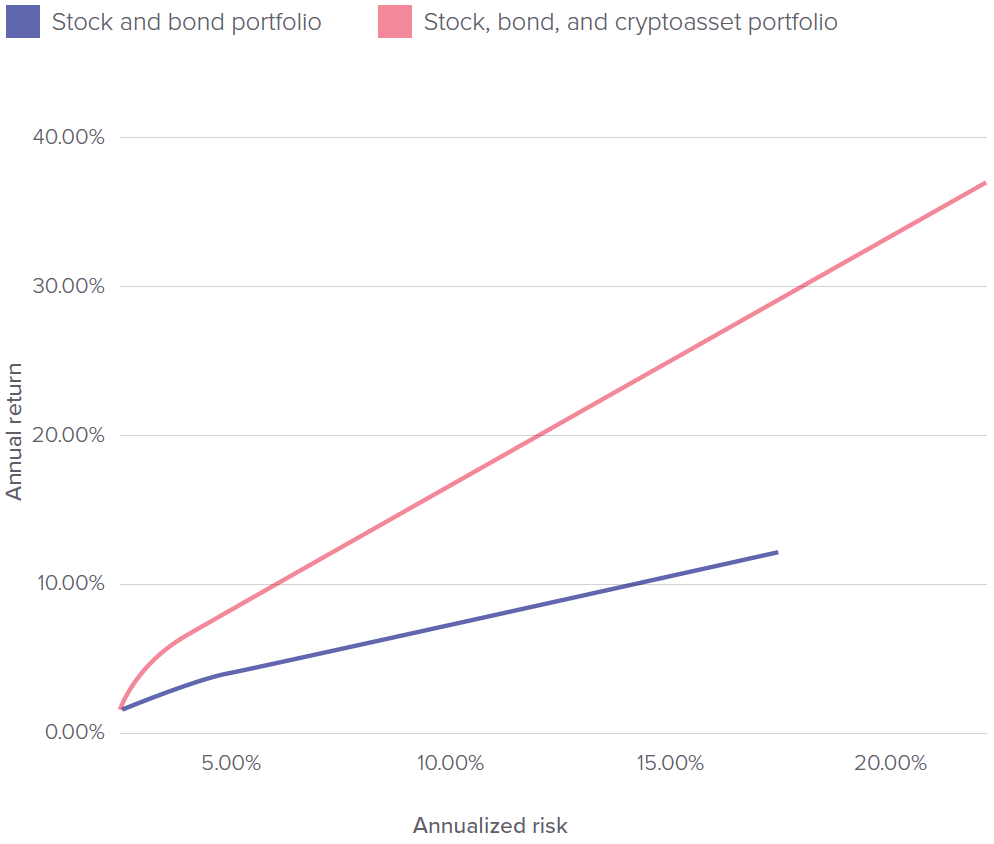
When cryptoassets are added to a two-asset portfolio of stocks and bonds, a higher rate of return is realized at all levels of volatility. For example, at a level of 10% annualized standard deviation, an investor would have obtained returns of 6.8% through an optimal stock and bond portfolio, whereas they would obtain returns of 15% through an optimal stock, bond, and cryptoasset portfolio.
In addition to the upward shift, the cryptoasset-augmented frontier extends upward and to the right to reflect the availability of portfolios offering greater returns at higher risk thresholds – a trade-off otherwise unavailable to less volatile stock and bond-only portfolios.
Importantly, the superior performance of the cryptoasset-augmented portfolios are subject to several important considerations.
Constraining cryptoassets leads to greater returns
Perhaps the most practical limitation of the above optimization is that its effects extend beyond simply making a cryptoasset allocation. Instead, optimizing a portfolio for the addition of a cryptoasset investment requires adjusting portfolio-wide weightings. For example, an optimal traditional portfolio constructed to target a 10% standard deviation might exist with weightings of:
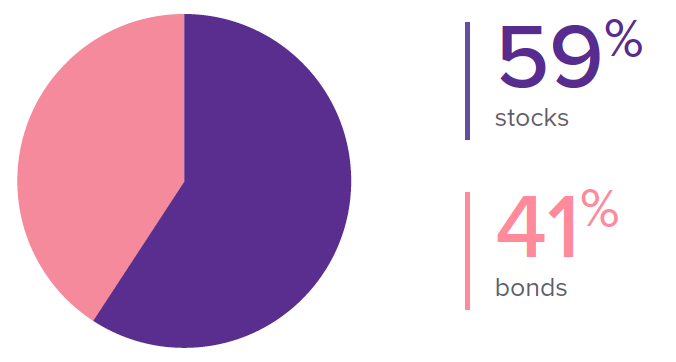
Augmented with cryptoassets and then optimized to target the same volatility, the new weightings become:
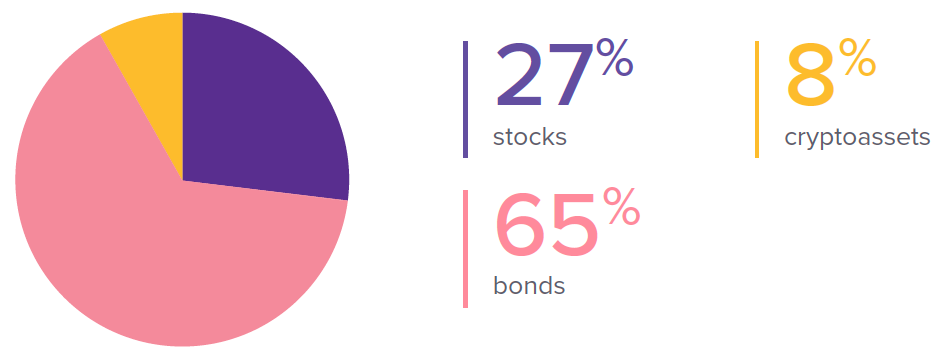
This reallocation could be problematic if an investor prefers to avoid adjusting their investment allocation to stocks and bonds. In the above example, maximizing returns at 10% annualized volatility in a cryptoasset augmented portfolio would lead to significant reallocation of stocks (reduced by 32%) and bonds (increased by 24%). Such dramatic change is not limited to to this example. Portfolio optimization consistently requires large, broad reallocations at any targeted level of volatility.
The following chart shows how an optimal allocation to stocks and bonds changes substantially for a targeted level of volatility, even with a small allocation of cryptoassets.
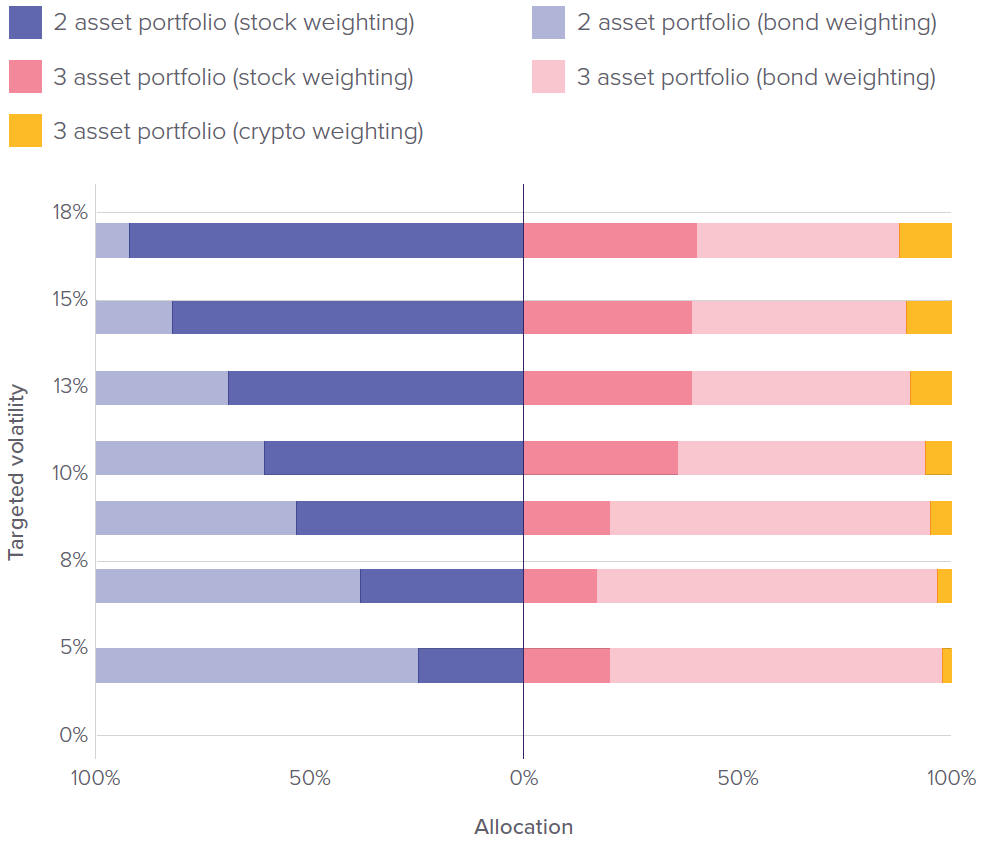
Toward the most extreme scenario, an investor targeting 17% volatility would shift stock weightings from 94% to 38%, once they had added cryptoassets and sought to optimize their portfolio. To avoid such a substantial reconstitution of their portfolio in adding crypto to a fully optimized portfolio, investors may be inclined to constrain their allocation changes.
Outperformance even amidst constraint
The chart below considers the impact of adding a small cryptoasset allocation without any further portfolio optimization, in a constrained frontier. The portfolios represented on this line are first constructed from optimal stock and bond portfolios, and then augmented with a 1% cryptoasset allocation, an amount posited as a maximal limit by the noteworthy investment advisor Ric Edelman.6
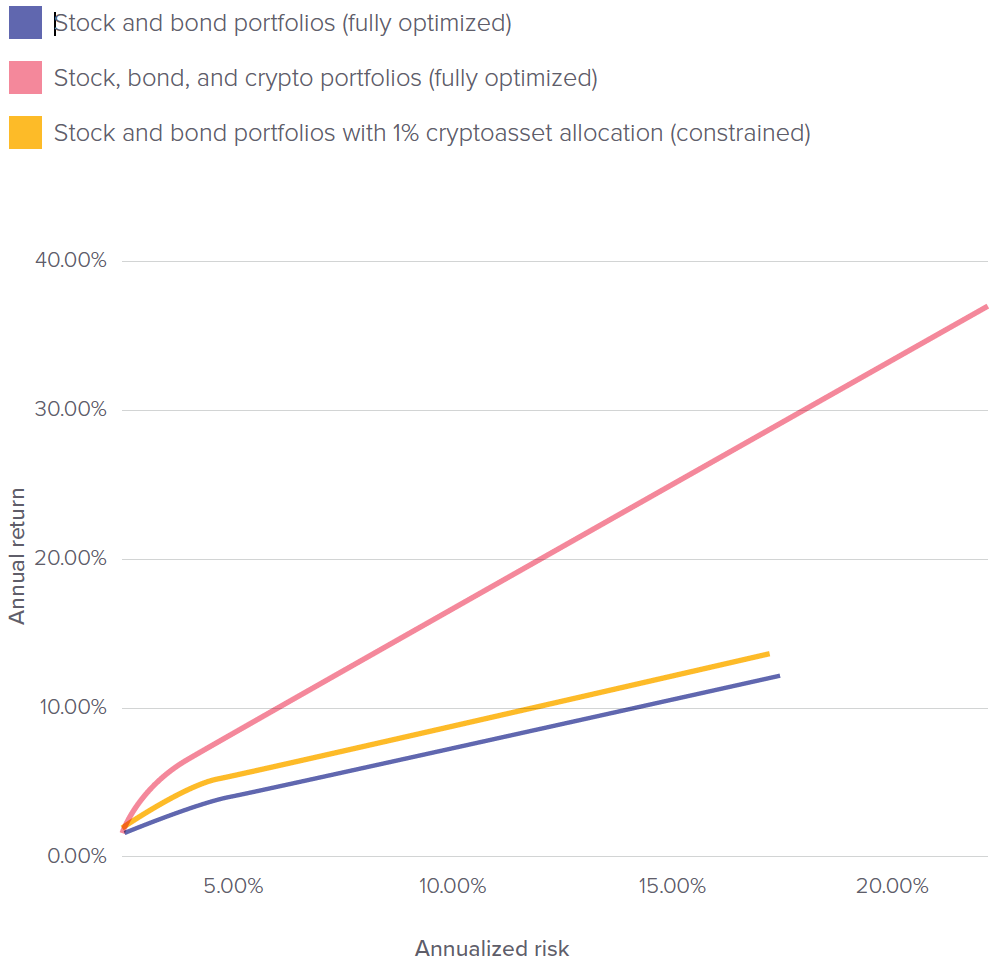
While a 1% cryptoasset allocation increased both risk and return, the outcomes across all portfolios nonetheless represent an upward shift in the stock and bond-only efficient frontier. Thus, for any given level of risk above the absolute minimum, the returns available to a constrained portfolio with 1% cryptoassets still exceeded those of a traditional asset portfolio.
Notably, the constrained set of portfolios generated lower returns than an optimized cryptoasset-augmented portfolio. This is an expected outcome of not optimizing portfolio weightings, reflecting the practical compromise inherent to avoiding broad reallocation of exposures.
Conclusion
Over the past decade, the cryptoasset market has demonstrated strong risk-adjusted performance that has been largely uncorrelated with traditional asset classes. The emergence of cryptoassets as a new asset class may pose opportunities for thoughtful investors to reap benefits, including diversification.
Note that investing funds in a portfolio targeting specific returns or risk levels may be highly sensitive to implementation considerations, such as rebalancing.7 The gap between expectations and reality could potentially be further widened by other important, less discussed aspects of cryptoasset investment such as market liquidity, cryptoasset forks, taxation, and regulatory compliance.
For the purposes of investment analysis, any conclusions drawn from historical analyses and projections should be rooted in a broader set of considerations yielding to careful and experienced judgment, and suitably matched to an investor’s sophistication and preferences.
Disclaimer: This paper was prepared for informational purposes only. It is not intended to provide financial or investing advice.
1 Cryptoassets: The Innovative Investor’s Guide to Bitcoin and Beyond, published in 2018 and written by investors and market commentators Chris Burniske and Jack Tatar provides a comprehensive taxonomy distinguishing cryptoassets and cryptocurrencies.
2 See Cryptoassets (2018), pages 83-120
3 Relevant proxies are used in all instances:
- Stocks: Vanguard Total Market Index Fund
- Bonds: Vanguard All Bond Index
- Cryptocurrencies: Bitcoin
4 See: Cryptoassets (2018), pages 132-135
5 Calculations based on data from coinmarketcap.com.
6 https://www.financial-planning.com/news/fraud-filled-crypto-assets-not-going-away
7 Existing research by Bitwise Asset Management shows the wide ranging divergence of outcomes yielded by changes in rebalancing thresholds and periods.


